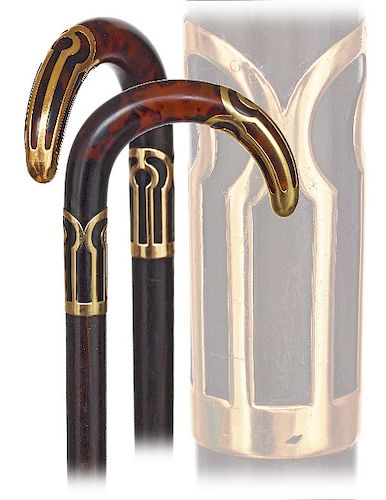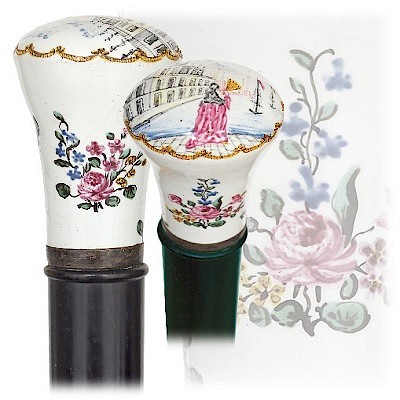34. Tortoiseshell and Gold Cane -Ca. 1910 -Solid tortoiseshell crook handle with matching and wide yellow gold cap and collar, well streaked makassar
Lot 34
About Seller
Kimball Sterling
125 West Market Street
Johnson City, TN 37604
United States
Family-owned and family-run Johnson City Tennessee auction business for 25 years. Selling antiques and collectables for 38 years. Kimball M. Sterling, Inc. was founded and is owned by Kimball and Victoria Sterling, time and again, they have laid solid claim to world-wide attention and renown with an...Read more
Categories
Estimate:
$800 - $1,200
Absentee vs Live bid
Two ways to bid:
- Leave a max absentee bid and the platform will bid on your behalf up to your maximum bid during the live auction.
- Bid live during the auction and your bids will be submitted real-time to the auctioneer.
Bid Increments
| Price | Bid Increment |
|---|---|
| $0 | $10 |
| $100 | $25 |
| $500 | $50 |
| $1,000 | $100 |
About Auction
By Kimball Sterling
Dec 8, 2018
Set Reminder
2018-12-08 11:00:00
2018-12-08 11:00:00
America/New_York
Bidsquare
Bidsquare : Antique Canes and Walking Sticks
https://www.bidsquare.com/auctions/kimball-sterling/antique-canes-and-walking-sticks-3643
A collection of 200 canes and walking sticks. Many different categories are presented in this single owner European collection Kimball Sterling kimballsterling@earthlink.net
A collection of 200 canes and walking sticks. Many different categories are presented in this single owner European collection Kimball Sterling kimballsterling@earthlink.net
- Lot Description
34. Tortoiseshell and Gold Cane -Ca. 1910 -Solid tortoiseshell crook handle with matching and wide yellow gold cap and collar, well streaked makassar ebony shaft and a brass ferrule. The tortoiseshell shows against the light the valued translucency of the precious organic material with captivating, dark and mottled brown-red colors, while the gold parts are delicately tooled with identical patterns and struck with tiny eagle heads hallmarks attesting for an 18 karat title and a French origin. Indeed, the symmetry of their design point to the emerging Art Deco taste and Age of Elegance, which was in turn marked by the increased production of luxurious and opulent small accessories. This cane is of the very highest quality and collectability, and a wonderful object to possess with the crossover appeal of associating with more than one collecting field to augment its value. -H. 3 ½” x 3 ½”, O.L. 32 ¼” -$800-$1,200 -Tortoiseshell canes were among the most expensive of their time. They were difficult to make, and few examples survived because of their excessive fragility. The carette turtle provided the best material for canes, and a tortoiseshell shaft required the largest six pieces of the 13 natural plaques of one, large turtle. The pieces had to come from a single animal, as each turtle had an individual, different grain. The lighter the color, the more appreciated the tortoiseshell. Paris specialized in tortoiseshell articles and had the best artists in that field. Today, the knowledge of handling tortoiseshell is totally lost. -Tortoiseshell is an ornamental material obtained from the curved, horny shields forming the shell of the Hawksbill or of the Caretta turtle. The marbled, variegated pattern and deep translucence of the plates have been used in veneering and in the manufacture of jewelry and other items since ancient times. Tortoiseshell was imported to Rome from Egypt and has found many uses throughout the centuries from the time it was first introduced to Europe by the East India Company in the 17th century. Tortoiseshell work was raised to the level of artistry with design applications such as veneer over wood with bone and ebony trimmings, marquetry, lacquered versions and inlays with gilded flowers, gold or silver. It became popular in the East as well as in Europe, where it was used as a material for jewel cases, trays, snuffboxes, canes and other decorative articles. Tortoiseshell is first separated from the bony skeleton by heat; the shields are flattened by temperature and pressure, and irregularities are rasped away. It can be molded after being softened in boiling oil, shaped on a lathe and also takes a beautiful polish. Current environmental concerns have limited the use of tortoiseshell, and the knowledge of handling this noble and beautiful material is now totally lost. -Tortoiseshell canes and handles were difficult to make and among the most expensive of their time. Few examples survived because of an excessive fragility.
- Shipping Info
-
Each auction has different shipping terms but the buyer always pays.Canes:After payment has been received we will ship in-house the domestic orders, International bidders will be shipped by the UPS store (423-979-7122) and email store4146@theupsstore.com After we receive payment we will deliver to the UPS store and they will contact you.Other Auctions:After payment has been received and cleared we will deliver your items to the UPS Store and they will quote and prepare for shipping.phone (423-979-7122 and email store4146@theupsstore.com
-
- Buyer's Premium



 EUR
EUR CAD
CAD AUD
AUD GBP
GBP MXN
MXN HKD
HKD CNY
CNY MYR
MYR SEK
SEK SGD
SGD CHF
CHF THB
THB



















